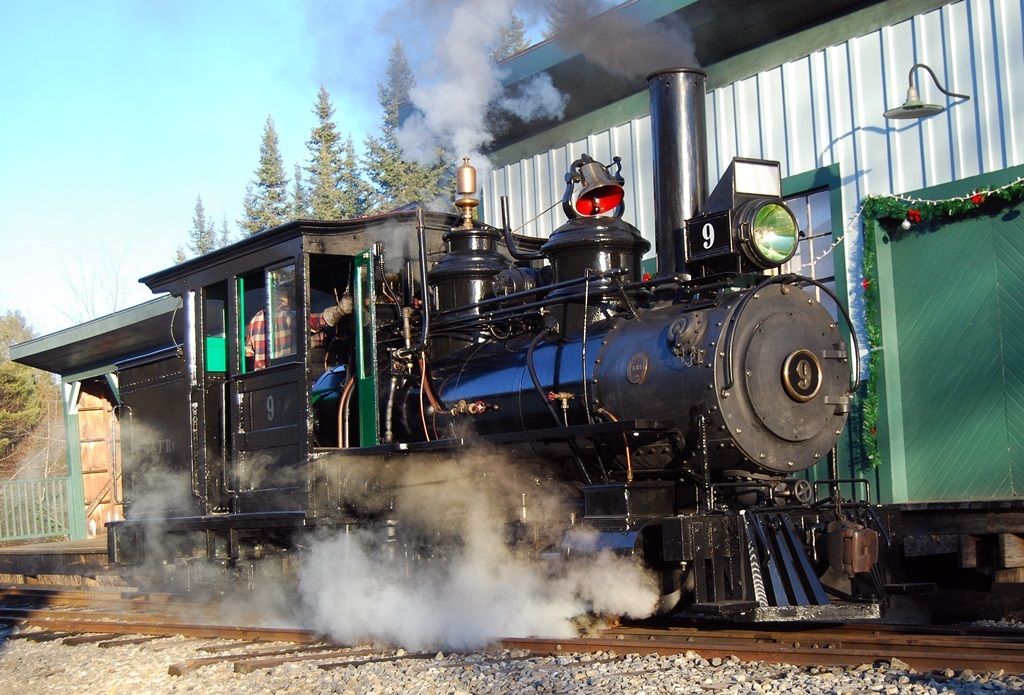In the late 19th Century, when the United States was beginning to develop a network of railroads, many prospective entrepreneurs chose to build narrow gauge lines, influenced by some which already existed in Europe. These "thin gauge" railroads have track where the distance between the rails is less than 4' 8 1/2", which is standard gauge. The most common width is 3', but a variety of other widths exist, such as 2' (common in Maine) and 30".
 |
| 3' gauge No. 6 on the Baltimore & Lehigh RR, a predecessor to the Ma & Pa. |
But why would anyone want to build a railroad that couldn't interchange cars with a standard gauge line? Well, this was the way to go for a cheap, quick, and easy railroad. Narrow gauge railroads provided great economic savings as they required smaller infrastructure and equipment. As a result, each railroad had a unique locomotive roster and owned all of the rolling stock on the line. Also, they could have tighter curves and steeper grades, allowing them to go places where standard gauge couldn't.
The narrow gauge boom quickly died out towards the turn of the century as most lines were either abandoned or consolidated to form a larger railroad which was converted to standard gauge. However, some managed to stick around.
 |
| Restored WW&F No. 9 in Alna, ME. |
A cluster of railroads with only two feet between the rails served the harbors, mills, quarries, forests, and farms of Maine from the 1870s to the 1940s. Their diminutive equipment included forney locomotives (0-4-4T and 2-4-4T) and boxcars that were 28' long. George Mansfield was influenced by a narrow gauge line in England, and as a result, he constructed the Billerica & Bedford in 1875, the first two-footer. Eventually, five two-foot railroads emerged from several mergers: Sandy River & Rangeley Lakes; Wiscasset, Waterville, & Farmington; Bridgeton & Saco River; Monson; and Kennebec Central. (These are in order from longest to shortest length.) The last in operation was the Bridgeton & Saco River, which closed in 1941. Fortunately, Ellis D. Atwood, bought its remaining equipment, along with two Monson locomotives and SR&RL rolling stock, which he operated on his cranberry plantation in Massachusetts. Eventually, his operation expanded into a tourist attraction, named the Edaville Railroad. Thanks to Atwood, many pieces of two-footer equipment were saved. Today, there are five locations with two-footer museums. (Some also have operating equipment, too!)
- Sandy River & Rangeley Lakes Railroad Museum - Phillips, ME
- Wiscasset, Waterville, & Farmington Railroad Museum - Alna, ME
- Bridgeton Historical Society Musuem (Bridgeton & Saco River) - Bridgeton, ME
- Boothbay Railway Village - Boothbay, ME
- Maine Narrow Gauge Railroad Co. & Museum - Portland, ME
 |
| No. 15 with a tourist excursion. |
The East Broad Top Railroad and Coal Company operated a 3' gauge line in central Pennsylvania. It transported coal from its mines to the Pennsylvania Railroad interchange in Mount Union, PA. Mount Union also was where the railroad conducted a unique process. It put narrow gauge trucks on standard gauge freight cars, which allowed them to be delivered to customers along the line. The railroad also provided passenger service using coaches and gas-electric "doodlebugs." In April 1956, operations ceased. The employees went home but never returned, and as a result, the shops and facilities were left exactly as they were in the 1950s. The railroad was purchased by the Kovalchick Salvage Corporation and was going to be scrapped, but fortunately, its president decided to reopen the line as a tourist attraction in 1961. It held public excursions until 2011, when the railroad was shut down again, because its owners and the East Broad Top Preservation Association (which operated the line from 2009-2011 through a lease) could not reach an agreement. Currently, it is cared for by members of
Friends of the East Broad Top and will hopefully be reopened sometime in the future.
There are many other narrow gauge lines still in existence. One that comes to mind is the Denver & Rio Grande Western. I'd write a summary about it, but most of my knowledge lies with railroads in the east.
Check back in the next week or so for the second part of this post which will concern modeling narrow gauge railroads, particularly by using HOn30 and On30 scales.




No comments:
Post a Comment